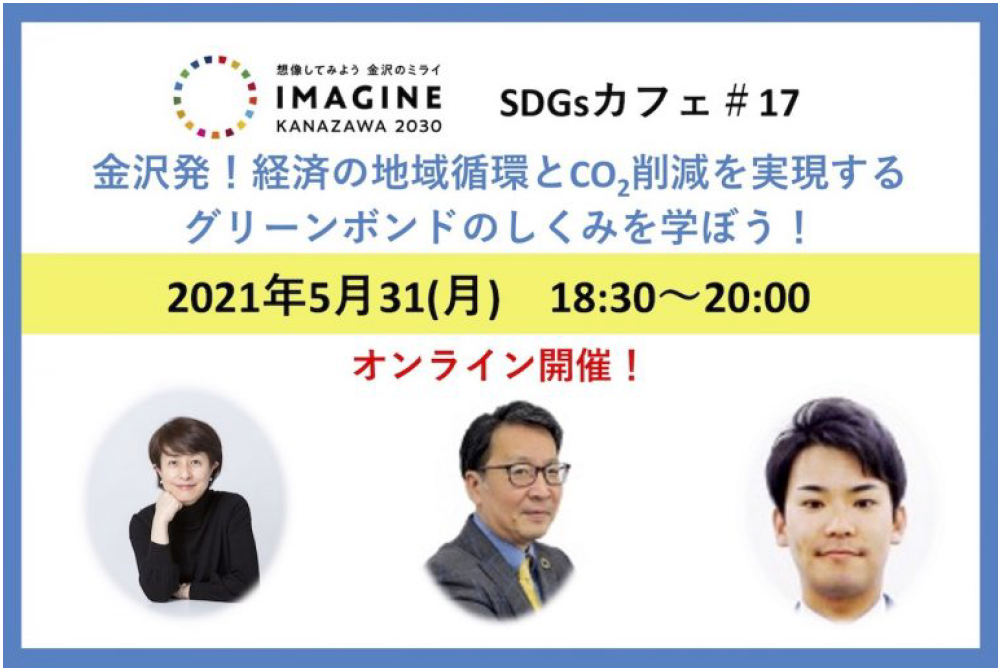The theme of the first SDGs café in 2021 was “green bonds”, a cashflow mechanism based on a new concept. Money is an important factor in the realisation of a sustainable society. This mechanism can not only solve environmental problems but also promote economic growth, and it might also contribute to the resolving of other issues.
Most large-scale green projects are implemented by large enterprises; therefore, money and jobs created by the projects often flow out of the relevant regions. However, a revolutionary project was born through collaboration between Kanazawa City, local financial institutions and other local companies. Bonds were issued to invest in the switching of city gymnasium lights to LED lights, in order to create monetary circulation in the regional economy. In this seminar, we learnt about the mechanism and possibilities of green bonds through this project.
Overview of green bonds and the project
We would like to explain the relevant technical terms first.
|
◆What are green bonds? Green bonds are bonds issued to fund green projects (global warming countermeasures, recyclable energy projects, etc.) by companies or local governments. They are also called social bonds or SDGs bonds. The proceeds from their issuance are to be used for the specified types of projects. ◆What is the project to switch city gymnasiums’ lights to LED lights? At present, about 3,000 mercury lights, which are controlled by the Minamata Convention on Mercury of the United Nations, are used in the 81 gymnasiums of elementary and junior high schools in Kanazawa City. This project intends to switch all the mercury lights to LED lights, thus reducing electricity usage, CO2 emissions and electricity expenses by two-thirds. ◆What are ESCO projects? In these projects, energy service companies (ESCO) help reduce utility costs paid by clients (a local government in this case) and receive rewards for surpluses due to the reduced costs. |
How can public-private partnerships based on private funds change Kanazawa by 2030?
President Hiroshi Sawada of Hokuriku Green Bond Co., Ltd. (the name changed to LGP Lab) talked about the establishment processes of his company and its tasks, and gave his thoughts about a society where public-private partnerships based on private funds prosper. (The following is a summary of his presentation.)
Despite the energy saving trend in companies, promoted by the Ministry of Economy, Trade and Industry, energy saving in local governments has not progressed well. Therefore, in June 2017, the ministry began to discuss PPP (public-private partnership) project models aiming for the improvement of the environments in local governments. However, local small and medium-sized companies were not proficient at comprehensive environmental management in spite of their advantages in specialised fields, which worked in the favor of large companies, causing money to flow out of regional communities. As a matter of fact, this has been one of the major reasons for the weakening of regional bodies following the period of Japan’s economic growth.
We visited the Ministry of the Environment to ask for advice regarding measures to make the most use of regional resources (people, products and funds). They recommended we construct a project scheme (a plan with a framework) and apply to become a green bond issuance model project. Thus, we established Hokuriku Green Bond Co., Ltd. in March 2018. In our system, a special purpose corporation (SPC), which connects local companies, governments and financial institutions, has been established for each project in order to issue bonds, obtain funds and implement the project.
For the first project, we decided on the task of switching lights in public buildings to LED lights, since the public sector was behind the private sector in this regard. This project was adopted as a green bond issuance model project by the Ministry of the Environment.
Then, we held a seminar for municipalities of the three prefectures in Hokuriku, and many of them attended the seminar. We found that the project had a market worth dozens of billions of yen. However, when it came to the point of negotiations with the municipalities, they would start saying “we don’t have enough money to do that” or “we don’t have to do that in a hurry”. In the end they always said “it is unprecedented”, and our negotiations ended.
However, in fiscal 2020, Kanazawa City advertised publicly for an ESCO project to switch gymnasium lights to LED lights. We applied for the project in consultation with local construction companies and a financial institution (Hokkoku Bank) and entered into a contract in September. Since all the parties involved are related to Kanazawa, this project was highly evaluated as an excellent example of a Regional Recreation SDGs Public-Private Partnership Platform by the Cabinet Office.
Local governments have many projects to implement, such as countermeasures for deteriorated facilities and natural disasters, as well as earthquake-resistance reinforcement, even though these public projects produce no profits. I think green bonds can be a solution to funding these projects.
Support for a regional PPP project from a financial institution
Yuki Bessho from the Solution Group of Hokkoku Bank talked about how they could realise this scheme.
Local governments are faced with difficulties in implementing countermeasures for deteriorating facilities constructed during the bubble economy period. Due to a decreasing number of employees, municipalities are unable to construct sustainable cities alone. We participated in the project of switching gymnasium lights to LED lights in response to consultation for funding from Hokuriku Green Bond. The reasons why we accepted their application were, firstly, the project was implemented through firm collaboration between public and private sectors, and secondly, it was led by local companies. The project cost was borne by the city, and the money became revenue for the participating local companies, providing stimulus. If the local economy is activated, it will result in an increase in taxation and a gain for local governments. This project is an excellent model for monetary circulation in communities and sustainable economic activation. I think local financial institutions should be actively involved in this kind of project.
Municipalities in the Hokuriku Region have their individual challenges. I hope that municipalities will share their troubles with local people and that local companies will speak out about what they can do to help. Then, this kind of partnership will increase, leading to sustainable city planning.
The seminar video is available on our Youtube Channel




